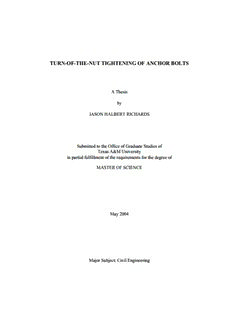
TURN-OF-THE-NUT TIGHTENING OF ANCHOR BOLTS - CiteSeer PDF
Preview TURN-OF-THE-NUT TIGHTENING OF ANCHOR BOLTS - CiteSeer
TURN-OF-THE-NUT TIGHTENING OF ANCHOR BOLTS A Thesis by JASON HALBERT RICHARDS Submitted to the Office of Graduate Studies of Texas A&M University in partial fulfillment of the requirements for the degree of MASTER OF SCIENCE May 2004 Major Subject: Civil Engineering TURN-OF-THE-NUT TIGHTENING OF ANCHOR BOLTS A Thesis by JASON HALBERT RICHARDS Submitted to Texas A&M University in partial fulfillment of the requirements for the degree of MASTER OF SCIENCE Approved as to style and content by: Peter B. Keating Paul N. Roschke (Chair of Committee) (Head of Department) Ray W. James (Member) Harry A. Hogan (Member) May 2004 Major Subject: Civil Engineering iii ABSTRACT Turn-of-the-Nut Tightening of Anchor Bolts. (May 2004) Jason Halbert Richards, B.S., Texas A&M University Chair of Advisory Committee: Dr. Peter Keating Double-nut anchor bolt systems are used in the erection of traffic signal poles, high-mast luminaries, and other highway appurtenances. An absence of a tightening standard for such systems decreases the confidence in their performance under fatigue loading. Past research has shown that a tightening standard should include the development of preload in the anchor bolt sufficient to provide adequate resistance to fatigue failure. Preload should be measured by a turn-of-the-nut method. Laboratory progressive tightening tests were performed in order to monitor the stress ranges occurring in the bolt at various locations of interest at various degrees of turn-of-the-nut tightness. Tests were performed on six diameters of anchor bolt ranging from 1 to 2-1/4 inches in diameter and two different categories of thread pitch: UNC and 8UN. Plots of stress range versus degree of tightness were developed for each test and evaluated to find the minimum degree of turn-of-the-nut at which stress range inside the nuts dropped below that outside the nuts. This shift was considered to be the principle theoretical indication of adequate performance. A fatigue test which saw failure outside the double-nut connection was set down as the practical indicator of adequate fatigue performance. The 2 inch 8UN bolt was chosen as the critical specimen due to its overall low generation of preload during tightening tests. Theoretical testing showed that 1/24 turn- iv of-the-nut would guarantee sufficient fatigue performance. Two practical fatigue tests of the bolt at that tightness saw one positive and one negative failure. After actual lab tests, finite element modeling was used to investigate the behavior of the bolt. It was found that performance did not see improvement until 1/12 turn-of-the-nut. After all results were considered, a standard of 1/6 turn-of-the-nut or refusal of tightening by specified methods was recommended, provided a minimum of 1/12 turn- of-the-nut was achieved. This value allows for ease of measurement, sufficient tightness, degree of safety, and has been shown in past testing not to cause failure through over- tightening. However, tightening to only 1/12 turn-of-the-nut still provided adequate performance. v DEDICATION I offer this thesis up for the glory of Jesus Christ my savior. I further dedicate this thesis to my parents, Hal and Christi, to my brothers, Travis and Chad, and to my fiancée, Susan. Your love and support have never failed me. vi ACKNOWLEDGEMENTS I would like to thank Dr. Peter Keating for his guidance and patience, Dr. Ray James for his support, Dr. Harry Hogan for his encouragement and example, and Lee Christian and Scott Hubley for all of their hard work. Thanks also to Andrew Fawcett, Jeff Perry, and Matthew Potter of TMRF and Rick Seneff of the TTI Machine Shop. Credit is given to the Texas Department of Transportation for funding this research, and to TxDOT engineers Mike Smith and Jim Yang for their involvement in and support of this project. vii TABLE OF CONTENTS Page ABSTRACT......................................................................................................................iii DEDICATION...................................................................................................................v ACKNOWLEDGEMENTS..............................................................................................vi TABLE OF CONTENTS.................................................................................................vii LIST OF FIGURES..........................................................................................................xii LIST OF TABLES...........................................................................................................xv 1 INTRODUCTION......................................................................................................1 1.1 Definitions........................................................................................................1 1.2 Problem history................................................................................................3 1.3 Fatigue..............................................................................................................4 1.4 Typical anchor bolt setup.................................................................................6 1.5 Basic preload theory.........................................................................................8 1.6 Adequate fatigue performance.........................................................................9 1.7 Past research, nationwide.................................................................................9 1.8 Past research, TxDOT....................................................................................11 1.9 Continuing research.......................................................................................14 1.10 Importance of failure location migration.......................................................14 1.11 Problem summary..........................................................................................15 1.12 Objective and criteria.....................................................................................16 2 METHODS..............................................................................................................17 viii Page 2.1 Progressive tightening test.............................................................................17 2.1.1 Bolt selection....................................................................................17 2.1.1.1 Bolt diameter.............................................................................17 2.1.1.2 Thread pitch...............................................................................18 2.1.1.3 Material grade...........................................................................18 2.1.1.4 Bolt and thread length...............................................................19 2.1.1.5 Galvanizing...............................................................................19 2.1.1.6 Availability................................................................................19 2.1.1.7 Base-plate selection...................................................................21 2.1.2 Specimen preparation.......................................................................22 2.1.2.1 Machining..................................................................................22 2.1.2.2 Strain gaging.............................................................................23 2.1.3 Experimental procedure...................................................................25 2.1.4 Data collection and assembly...........................................................32 2.1.4.1 Preload data...............................................................................32 2.1.4.2 Fatigue data...............................................................................32 2.2 Tightening tests..............................................................................................33 2.2.1 Bolt selection....................................................................................33 2.2.2 Base-plate selection..........................................................................34 2.2.3 Specimen preparation.......................................................................34 2.2.4 Experimental procedure...................................................................36 2.2.5 Data collection and assembly...........................................................37 ix Page 2.3 Fatigue test.....................................................................................................37 3 LABORATORY RESULTS....................................................................................39 3.1 1 inch, 8UN specimen....................................................................................39 3.1.1 Presentation of graph........................................................................39 3.1.2 Presentation of stress range table.....................................................42 3.1.3 Interpretation of stress range data....................................................42 3.1.3.1 Questions raised........................................................................42 3.1.3.2 Behavior inferences...................................................................43 3.1.4 Presentation of preload table............................................................44 3.2 Initial conclusions..........................................................................................46 3.3 Tightening test data........................................................................................46 3.3.1 Preload generation............................................................................47 3.3.2 Turn-of-the-nut feasibility................................................................52 3.3.3 Initial conclusions............................................................................53 3.4 Verification....................................................................................................54 3.4.1 Selection of the critical specimen....................................................54 3.4.2 Fatigue verification..........................................................................56 3.4.3 Verification by finite element analysis............................................59 4 FINITE ELEMENT ANALYSIS RESULTS..........................................................60 4.1 Model development........................................................................................60 4.1.1 Model construction...........................................................................60 4.1.2 Boundary conditions........................................................................63 x Page 4.1.3 Model convergence..........................................................................64 4.1.4 Model loading..................................................................................66 4.2 Analysis..........................................................................................................69 4.3 Laboratory and FEM results comparison.......................................................73 4.3.1 Outside stress range drop-off...........................................................74 4.3.2 Top and bottom stress range separation from middle......................75 4.3.3 Effects of gage depth........................................................................76 5 CONCLUSIONS AND RECOMMENDATIONS..................................................81 5.1 Conclusions....................................................................................................81 5.1.1 Regarding the turn-of-the-nut generation of preload.......................81 5.1.2 Regarding the accuracy of laboratory and finite element testing.....82 5.1.3 Regarding the proposed uniform tightening standard......................82 5.2 Standard recommendation..............................................................................83 5.3 Recommendations for continued research.....................................................83 5.3.1 Standard verification........................................................................84 5.3.2 Standard refinement.........................................................................84 5.3.3 2 inch UNC turn-of-the-nut feasibility study...................................85 REFERENCES.................................................................................................................86 APPENDIX A PROGRESSIVE TIGHTENING DATA.........................................88 APPENDIX B TIGHTENING DATA.....................................................................99 B.1 UNC tightening data summaries....................................................................99 B.2 8UN tightening data summaries...................................................................102
Description: